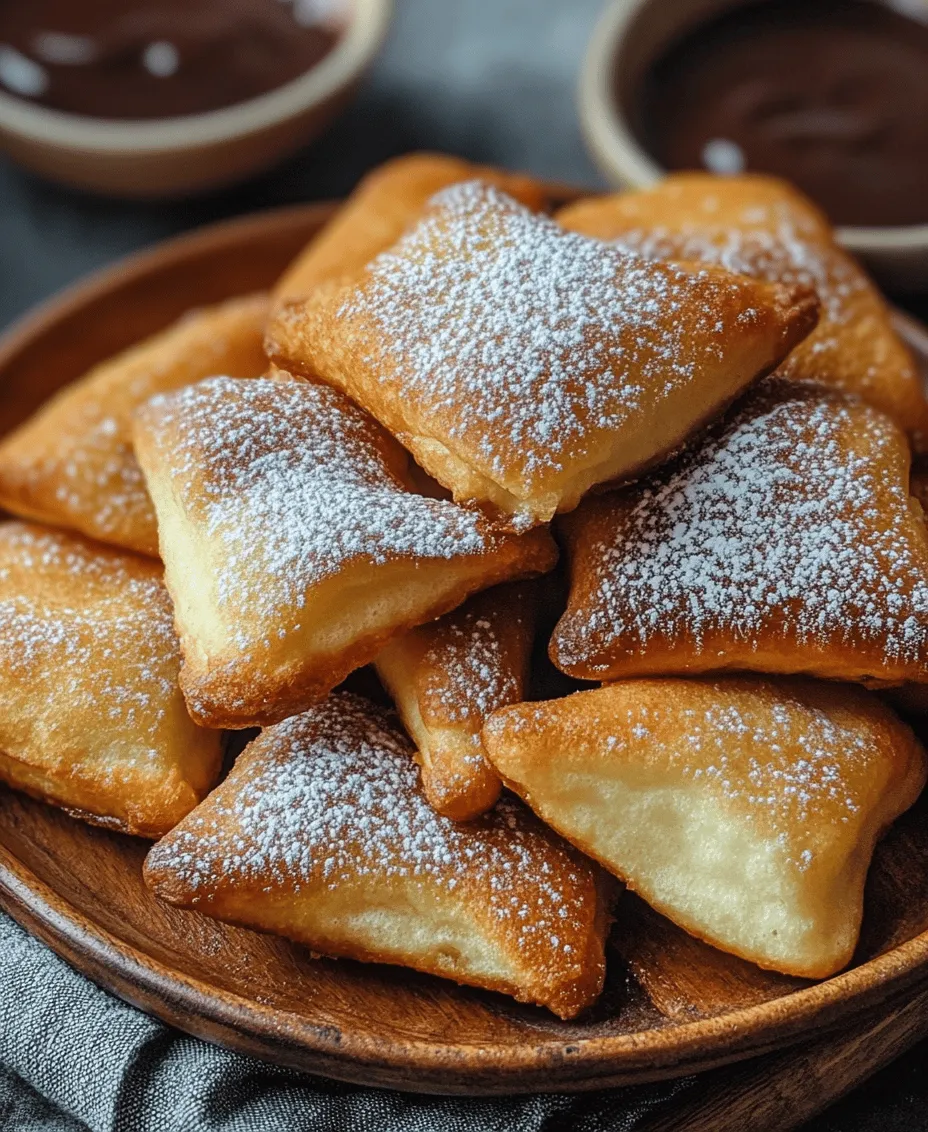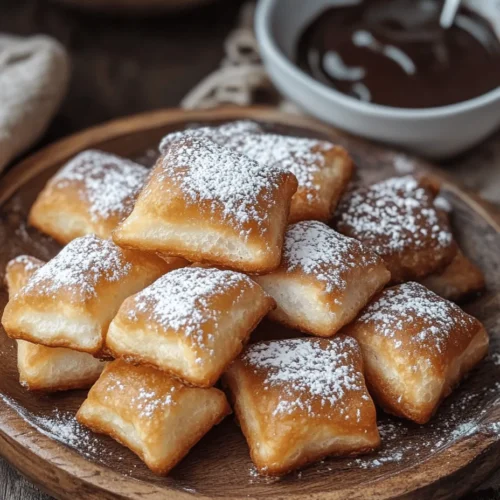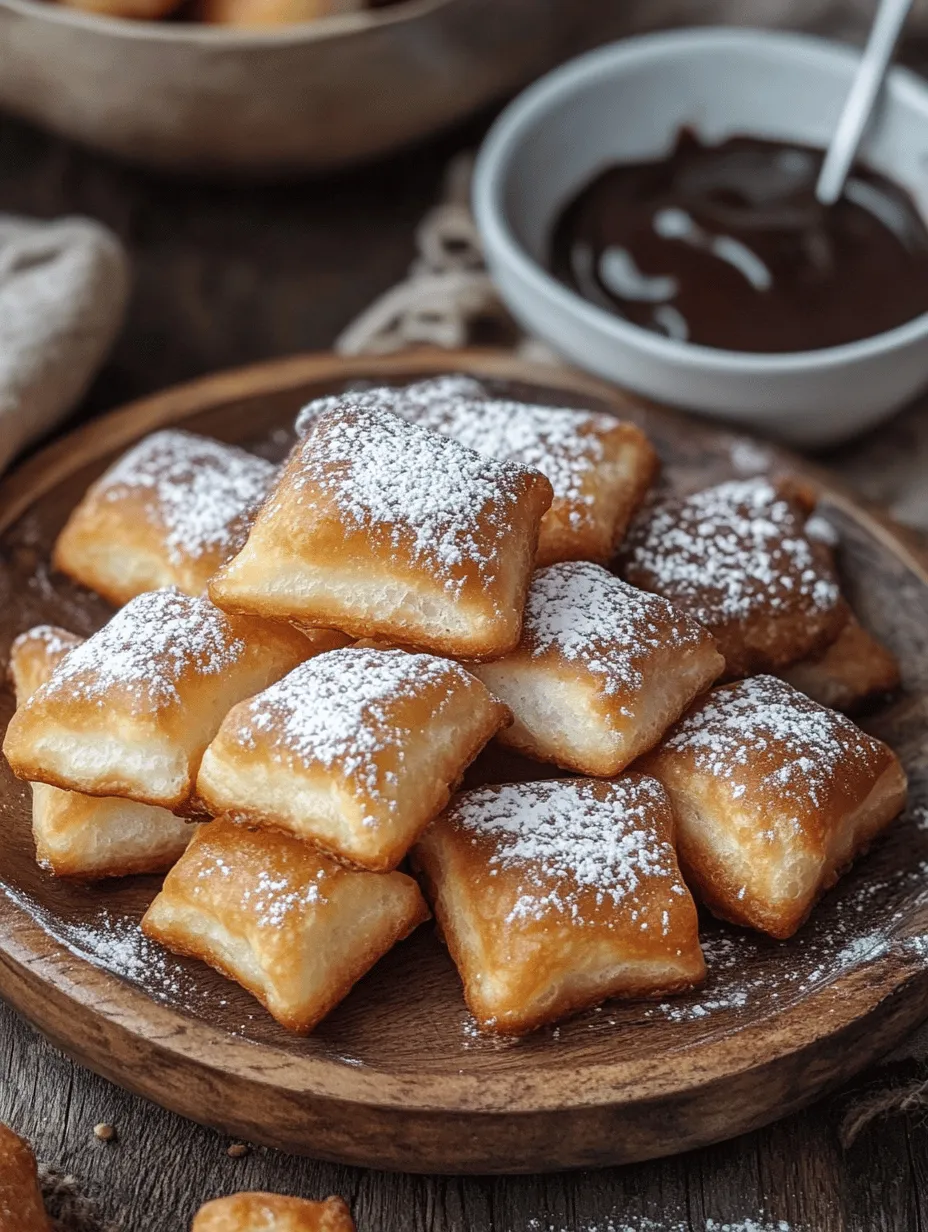Introduction
Step into the enchanting world of beignets, where each bite transports you to the charming streets of New Orleans and the quaint cafés of Paris. Beignets, often compared to doughnuts but with their own unique personality, are delightful pastries that have captured the hearts and taste buds of many. Their fluffy interiors and golden exteriors, scented with a hint of vanilla, make them an irresistible treat for breakfast, dessert, or any celebratory occasion. The allure of Vanilla French Beignets lies not only in their sweet, comforting flavor but also in their simplicity—perfect for both novice and experienced bakers alike.
Imagine waking up to the warm aroma of freshly made beignets wafting through your kitchen, ready to be shared with family and friends. These little pockets of heaven are not just a treat; they are a culinary experience that brings joy and creates lasting memories. With easy-to-follow steps, making these delectable pastries at home becomes a delightful journey rather than a daunting task. So, roll up your sleeves and prepare to indulge in a sweet adventure that is as fun to make as it is to savor!
The History of Beignets
The story of beignets is one steeped in rich tradition and cultural significance. Originating in France, the term “beignet” translates to “fried dough,” and it is a culinary concept that dates back centuries. The French beignet is typically made from a simple dough that is fried until golden brown and often dusted with powdered sugar—an indulgent treat that has become a staple in French cuisine.
As French settlers made their way to Louisiana in the 18th century, they brought with them their culinary traditions, including the beloved beignet. Over time, these pastries evolved, adapting to the local ingredients and tastes. In New Orleans, beignets became synonymous with the city’s vibrant culture and culinary landscape, particularly in the famous Café du Monde, where patrons flock to enjoy them with a steaming cup of café au lait.
In New Orleans, beignets are often associated with celebrations and special occasions, symbolizing a sweet treat that brings people together. They are not just a dessert; they embody a sense of community and festivity. Today, beignets are enjoyed worldwide, with various regional variations emerging—from the savory versions in some cultures to the sweet, dusted ones that we adore. The Vanilla French Beignet, with its aromatic infusion of vanilla and soft, fluffy texture, is a testament to this delicious legacy, bridging the gap between tradition and contemporary indulgence.
Ingredients Overview
Creating the perfect Vanilla French Beignets requires a thoughtful selection of ingredients, each playing a crucial role in crafting the ideal texture and flavor profile. Below is a detailed breakdown of the key ingredients that will come together to create these delightful pastries:
All-Purpose Flour
All-purpose flour serves as the foundation for the beignet dough. Its moderate gluten content provides the structure needed to achieve that airy, fluffy texture we all crave. While some recipes may call for cake flour, all-purpose flour strikes the right balance, allowing for a tender crumb without sacrificing stability.
Granulated Sugar
Granulated sugar is essential for adding sweetness to the beignet dough. It not only enhances the flavor but also contributes to the browning of the pastries during frying, resulting in a golden exterior that is visually appealing. The sugar’s crystalline structure helps create a light and delicate texture, ensuring that each bite melts in your mouth.
Baking Powder
Baking powder is the leavening agent that gives beignets their signature fluffiness. When combined with the wet ingredients, it activates, creating bubbles that expand during frying, resulting in light and airy pastries. This is crucial in achieving the perfect beignet texture, where the inside is soft and pillowy, contrasting beautifully with the crispy exterior.
Ground Cinnamon
A pinch of ground cinnamon adds warmth and spice to the beignet dough, elevating the flavor profile and providing a comforting aroma. This subtle spice is a classic addition that complements the sweetness of the vanilla, creating a harmonious balance that makes each bite even more delectable.
Eggs
Eggs play a vital role in binding the ingredients together, providing richness and enhancing the overall flavor of the beignets. The proteins in eggs help create a stable structure in the dough, while the fat contributes to a moist and tender texture. They are an essential ingredient that ensures your beignets turn out perfectly every time.
Whole Milk
Whole milk adds moisture to the dough, contributing to the beignets’ soft texture. It also helps dissolve the sugar and other dry ingredients, creating a smooth batter that fries beautifully. The richness of whole milk enhances the overall flavor, making the beignets taste indulgent and satisfying.
Vanilla Extract
Vanilla extract is the star ingredient in Vanilla French Beignets, infusing them with a sweet aroma and delightful flavor. Using pure vanilla extract, as opposed to imitation, ensures that the beignets have that rich, authentic taste that makes them truly special. This ingredient not only elevates the overall flavor but also adds to the sensory experience of enjoying these pastries.
Unsalted Butter
Unsalted butter enriches the beignet dough, adding depth and flavor. It contributes to the tenderness of the pastries, ensuring that they are not only delicious but also have a pleasing mouthfeel. Using unsalted butter allows for better control of the overall salt content in the recipe, ensuring a balanced flavor profile.
Powdered Sugar
Powdered sugar is the finishing touch for Vanilla French Beignets. After frying, a generous dusting of powdered sugar adds sweetness and a pleasing visual appeal. This light, fluffy sugar melts slightly upon contact with the warm beignets, creating a delightful contrast between the sugary exterior and the soft, airy interior. It’s the hallmark of a classic beignet presentation and elevates the indulgent experience.
These ingredients come together to create a delightful treat that is not only easy to make but also perfect for sharing. With their rich history and cultural significance, Vanilla French Beignets are a delicious way to celebrate both tradition and culinary creativity.
In the next part of this article, we will delve into the step-by-step instructions that will guide you through the process of making these heavenly pastries in your own kitchen. Get ready to embrace the sweet joy of homemade beignets!

Step-by-Step Guide to Making Vanilla French Beignets
Creating the perfect Vanilla French Beignets is a delightful process that combines simple ingredients with a touch of culinary finesse. Each step is crucial for achieving that light, fluffy interior encased in a crisp, golden exterior. Follow this detailed guide to ensure your beignets are a hit!
Preparation of Dry Ingredients
Start by preparing your dry ingredients. In a medium-sized mixing bowl, combine 2 cups of all-purpose flour, 1/4 cup of granulated sugar, 1 tablespoon of baking powder, and a pinch of salt. Whisk these ingredients together vigorously for about a minute to ensure they are well combined. This step is essential as it helps to distribute the baking powder evenly throughout the flour, which is key to achieving that perfect rise in your beignets. A uniform mixture will lead to even cooking and a consistent texture in the final product.
Creating the Wet Mixture
In a separate bowl, it’s time to prepare the wet mixture. Whisk together 2 large eggs, 1/2 cup of whole milk, and 1/4 cup of melted unsalted butter until the mixture is smooth and creamy. Incorporating the ingredients thoroughly is essential; the eggs provide structure, the milk adds moisture, and the butter enriches the flavor. The result should be a silky batter that is free of lumps. This wet mixture will ensure your beignets are moist and flavorful.
Forming the Dough
Now, combine the dry and wet mixtures. Gradually add the wet mixture into the dry ingredients, stirring gently with a spatula or wooden spoon. Be careful not to overmix; stop when the dough comes together but is still slightly sticky. If the dough feels too wet, you can add a little more flour, but aim to keep it soft and pliable. The ideal consistency is similar to a thick pancake batter—smooth but not overly sticky. This dough will yield light and airy beignets.
Shaping the Beignets
Once your dough is ready, turn it out onto a lightly floured surface. Gently pat the dough into a rectangle about 1/2 inch thick. To cut your beignets, use a sharp knife or a pizza cutter to slice the dough into squares or rectangles, ideally 2 to 3 inches wide. For an elegant touch, you can also cut them into triangles or use a doughnut cutter for round shapes. Ensuring uniformity in size will help them cook evenly. Place the cut pieces on a floured baking sheet as you prepare to fry them.
Frying Technique
Heat vegetable oil in a deep fryer or a heavy-bottomed pot to a temperature of 350°F (175°C). It’s crucial to maintain this temperature for the best frying results. If the oil is too hot, the beignets will brown too quickly on the outside while remaining raw inside; if it’s too cool, they will absorb too much oil and become greasy. To test if the oil is ready, drop a small piece of dough into the oil; it should sizzle and rise to the surface quickly.
Carefully lower a few beignets into the hot oil, ensuring not to overcrowd the pot. Fry them for about 1-2 minutes on each side or until they are a beautiful golden brown. Using a slotted spoon, remove them from the oil and place them on a plate lined with paper towels to absorb excess grease.
Final Touch
While the beignets are still warm, dust them generously with powdered sugar. This step is not just for aesthetics; the heat from the beignets helps the sugar stick, creating a delightful sweetness that complements the rich flavors within. Serve them warm for the best experience—there’s nothing quite like the aroma of freshly fried beignets wafting through your kitchen!
Serving Suggestions and Pairing Ideas
While Vanilla French Beignets are delightful on their own, there are many creative ways to elevate your serving experience:
– Dipping Sauces: Consider pairing your beignets with various sauces. Chocolate sauce, fruit preserves, or flavored creams (such as vanilla or coffee-infused whipped cream) can enhance the flavor profile and add an interactive element to your dessert.
– Beverage Pairings: Complement your beignets with the right beverages. A steaming cup of coffee or hot chocolate makes for a perfect match, enhancing the sweetness of the beignets. For a sophisticated touch, try serving them with a sweet dessert wine or a sparkling cider.
– Presentation: If you’re serving beignets for a special occasion, consider presenting them on a beautiful platter garnished with fresh berries or edible flowers. This not only enhances the visual appeal but also adds to the overall experience, making them perfect for events or gatherings.
Nutritional Information
Each serving of Vanilla French Beignets (approximately two beignets) contains roughly 300-350 calories. The nutritional content includes about 15 grams of fat, 38 grams of carbohydrates, and 10 grams of sugar. To make these treats a bit healthier, consider using whole wheat flour for added fiber or reducing the sugar in the dough. You can also explore alternatives such as coconut oil instead of butter or a sugar substitute, depending on your dietary preferences.
Conclusion
Making Vanilla French Beignets at home is not just about creating a delicious pastry; it’s an opportunity to bond with family and friends over the joys of cooking. These delightful treats encapsulate the essence of indulgence and celebration, perfect for any occasion. As you embrace the process of cooking and baking, remember that the memories created in the kitchen are often the sweetest. So, roll up your sleeves, gather your loved ones, and celebrate the sweet moments that life has to offer through these delightful beignets. Enjoy every bite and the smiles they bring!


